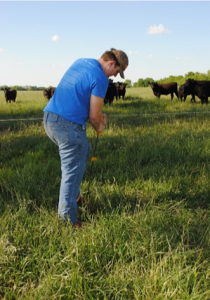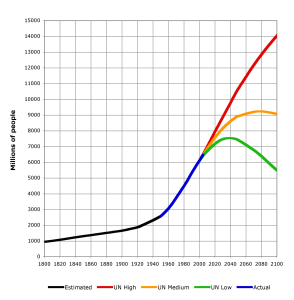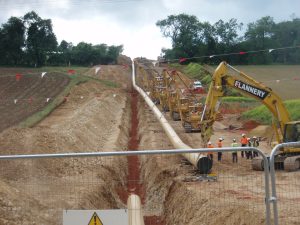Published on June 3, 2019
Many reasons for the “apocalyptic” demise of the Mayan civilization have been hypothesized including the occurrence of a severe drought, thought to be exacerbated by rapid deforestation. Extensive logging was conducted to clear the land for growing more food and for producing construction materials needed to accommodate the growing population’s cityscape, further magnifying the environmental impact on the Mayan population. This drought would have left the population at risk, the larger the population, the larger the risk. With the continued rise in the population of the United States, a similar fate of apocalyptic magnitude seems plausible. At a current 327 million people in U.S. (US Census Bureau, 2018), overpopulation is at the core of many U.S. environmental issues. Understanding this challenge is a necessity for today’s millennials and the aging population alike. Population growth factors, governmental regulations, carrying capacity, and scientific discoveries all contribute to this diverse subject. Too many humans will impair the environmental health of the United States. Whether it is due to the overconsumption of natural resources, food, and energy; the degradation of soils and deforestation; or the overwhelming production of waste and pollution, the overpopulation of the U.S. may cause its own apocalyptic demise.
Population Growth
Population growth established through improved medical treatments and a better standard of living, when coupled with a general lack of population harm, continues to inadvertently threaten the environment. While birth control has improved, reducing what might otherwise be uncontrolled numbers of people, population continues to rise, threatening the environment in the United States as a result.
Improvements in medical treatments maintain this population growth. The advancement of medical technology and the discovery of many life-saving drugs have produced a dramatic climb in the U.S. population over this past century. The x-ray in 1895, penicillin in 1928, and the polio vaccine in 1952, were just a few of these lifesaving innovations (Laal, 2012). These discoveries boosted the U.S. population to its current level and will continue to further increase that growth exponentially.
Population correction is a hard truth for any civilization, but by reducing population numbers, whole generations are removed from the reproductive pool, slowing exponential growth. The loss of approximately 750,000 Americans in both World Wars (National WWII Museum, 2018), 58,000 in Vietnam (U.S. National Archives, 2016), and an additional 675,000 Americans to the Spanish Flu of 1918 (UNT Libraries CyberCemetery, 1969), limited the U.S. population growth, at great cost. These were tragic events which devastated many American families, but what if these Americans had survived. The exponential growth in the population would be staggering, adding additional demand on natural resources to an already strained ecosystem. Think about it. If each victim of the Spanish Flu had married another and had two children in each subsequent generation, then they would account for roughly 2 million more people today, and 4 million more in the next generation.
Tighter Governmental Regulations Combat Some Pollution
Tighter governmental regulations introduced over the past 50 years have combated some air and water pollution problems caused by an increasing population. However, new regulatory rollbacks may once again threaten the environment in the name of the economy. Once stalled due to their adverse environmental impact, the U.S. government renewed the construction of the Dakota Access and Keystone XL oil pipelines, rolled back regulations against the dumping of coal mining debris into streams, and rejected a ban on pesticides potentially affecting food production (Popovich and Schlossberg, 2017).
Conservationists argue animals, such as the swift fox, the whooping crane, and the burying beetle, will be adversely affected by the Keystone Pipeline. Environmental activists claim both pipelines delay investment into renewable energy and increase reliance on fossil fuels, threatening the U.S. environment (Sierra Club et al., 2011). However, with the rising U.S. population comes demand for increased energy production. As a result, the construction of the pipeline was reopened. The White House stated that the positive economic impact and energy independence of these two pipelines outweighed the potential environmental risk they posed (Denchak, 2017).
This same economic priority prompted the current administration to revoke the rules, established by the previous administration, that were associated with coal debris stream dumping. The current administration cited coal miners returning to work as the deciding factor. The position of the White House, mirrored by many Americans, cited that the positive economic impact again outweighed the impact on the environment. Other regulatory decisions may also become a necessity to increase food production for the U.S., while negatively affecting the environment.
While the U.S. government from 2008-2016 called for a ban on potentially harmful pesticides, such as Chlorpyrifos, the now former 2017 appointed Environmental Protection Agency (EPA) Chief Scott Pruitt rejected this notion, citing a need for further testing. Protecting food producers from overreaching governmental regulation strikes a positive note with farmers as well as hungry American consumers who understand the need for increased yields. Pruitt understood that farmers need multiple options, as well as reduced regulatory control to feed the masses.
Producers are being called upon to feed more people with less land. The problem is that large portions of productive agricultural land have been converted to residential housing and commercial buildings, further lowering the usable acres of agricultural lands (Bennett, 2018). As our population grows, the need for affordable housing for these new people also grows. Coming full circle, with less agricultural lands to use, this expansion can, at best, lead to lower total productivity. At its worst, this need for further expansion can unfortunately lead to the wholesale destruction of ecosystems such as wetlands and forests.
Another example of environmentally-friendly regulatory action receiving opposition from farmers, ranchers, and energy companies would be the Waters of the U.S. (WOTUS). Based on the Clean Water Act of 1972 and the Clean Water Rule of 2015, WOTUS gave the EPA control over any body of water including those on private land. Although applicable in 22 states, the Trump administration called on the EPA to review their stance on WOTUS due to its negative impact on agriculture and industry. Missouri cattleman, Brad Guinn, joined other concerned producers in opposition to the highly controversial WOTUS stating, “As it stands now, if overreaching regulations such as WOTUS were to become law, even with its environmental positives, protein producers of the nation would be bankrupted” (Guinn, 2017). The protection of U.S. water from pollution and degradation in the face of overpopulation is important but must be balanced with the need for production of food and energy in order to sustain its population.
All these issues stem from the needs of our large population. We need power and oil to sustain our economy and our industries. People need jobs so they can provide for themselves and their families. Unfortunately, this means that jobs such as coal mining cannot be disbanded even though they have a harsh environmental impact. Also, there must be regulations for water quality to protect people. The unfortunate side effect of regulation is that too much regulation can harm agricultural production and profit, compounding the effect of the over population. If production becomes limited, then so does the room for the population to grow. Regrettably, most people would rather cause environmental harm than take steps to limit population growth.
The Analogy of Carrying Capacity
The analogy of carrying capacity as it relates to the environment is both insightful and graphic. The definition of carrying capacity is the number of living organisms or crops that a region can support without environmental degradation. In nature, exceeding this number leads to rapid population die off. Understanding the concept, while gaining insight into personal perceptions of the subject, becomes easier when reinforced through learning-by-doing

Example of well managed carrying capacity, cattle on lush grass with ample clean water to drink. Photo by Cole Diggins
As an example, I grew up on a cattle ranch and instinctively understood the truth of carrying capacity, where the earth can only grow as many beef cattle (or humans) as it can comfortably sustain. With the environmental changes we are beginning to see, such as drought, there will come a time when there is less water than the current herd requires, and its health will suffer. With the just need of sustaining human life, what water is needed for crop and animal production will have to be diverted for human consumption. This compounds the lack of water and can ultimately result in a lack of food. This is a case Texas rancher, Mr. Robert Mayville, has felt firsthand and stated in an interview, “Our ranch has been in my family for six generations and because of the extensive drought in our area we were forced to sell our entire herd, nearly 2,000 head. The ground just cracked and swallowed up all of our dreams with it” (Mayville, 2016).
While carrying capacity is not an apparent issue when pastures are fertile, wet, and thriving, when drought or other changes occur carrying capacity becomes the largest issue. If the carrying capacity of the United States was ever reached, leading to the natural depletion of any one natural resource, the country would be in serious trouble. Afterall, there is no backup plan. As an example, the Roman Empire fell, due in part to the destruction of its topsoil (Montgomery, 2012). Overworking of the land to produce more food for the empire’s growing population became unsustainable. As humans cannot survive without water or topsoil to grow food, exceeding carrying capacity would leave the U.S. to fall in much the same way as the Roman Empire, plagued by its lack of useable resources and overabundance of people. Luckily, unlike the Romans we have better technology to help us sustain our resources and utilize them more efficiently.
Increasing Population vs. Food Production vs. Environmental Cost
Genetically modified grain varieties have earned somewhat of a negative stigma over the past few years. Columnists suggest they are unsafe for consumption, when in fact heirloom varieties would likely not produce enough food to feed the population (Elmore et al., 2001). Additionally, Genetically Modified Organisms (GMO) offer more environmental positives than their heirloom counterparts. GMOs have been modified to require less water, utilize fertilizer more efficiently, and require fewer toxic pesticide applications (Buiatti et al., 2013). Grain varieties accomplish this by utilizing the power of genetics in crops. For example, SmartStax® corn has an inserted B. thuringiensis (BT) gene that protects the corn against harmful insects. The BT gene produces a toxin which kills certain insects that ingest the crop, stopping further damage.
Although critical to crop growth, phosphorous and nitrogen in fertilizers have been found to adversely impact area streams and fish populations by creating hypoxic dead zones in oceans and streams all over the U.S. (Diaz and Rosenberg, 2008). Phosphorus over abundance is typically a result of meeting the required soil nitrogen concentration for food production by utilizing manure. In doing so, many soils, especially in southwest Missouri, fall within the high to extreme level of the P-Index. The P-Index is essentially a rating of how likely the phosphorus is to pollute a watershed (NRCS, 2004). Although limiting the use of manure could be a solution, there would be no way to dissipate the manure’s environmental impact after it is produced. This would leave producers to rely almost solely on industrially-produced nitrogen fertilizer, a leading producer of Carbon Dioxide emissions worldwide (Lal, 2004).
The Haber-Bosch process, an industrial nitrogen fixation process, used to create nitrogen fertilizer, accounts for more than a third of all life on Earth. The more organisms there are in a population, the more nitrogen is needed to sustain that population. With an increasing population, more energy is required to produce the nitrogen fertilizer, which depletes the natural resources needed to sustain this same increasing population. This leads to an unsustainable semi-cyclical pattern with many non-renewable losses eventually culminating in a lack of resources, namely oil and natural gas, used in this high energy reaction. With an increasing population, comes an increased need for nitrogen and the increased environmental impact it brings. As a future scientist, I am ever optimistic about our achievements, feeding more with less, but as a naturalist, I am equally concerned as to the environmental cost.

This graph represents the amount of people on Earth over time. This steep increasing line is the product of the exponential growth discussed. If this continues to grow with no corrections, there will be ~3 billion more people on Earth by 2050 (United Nations, 2014). Lauren Cobb cc
Summary and Conclusion
To summarize, if population growth of the country cannot be stalled, agriculturists, economists, and all U.S. citizens will need to find common ground with environmentalists to preserve the American way of life. The longer the country waits to make this decision, the more dangerous the consequences. Governmental regulations are necessary to protect the environment and are often created to offset the damages attributed to population growth. However, these need to be tempered with the well-being of the U.S. economy and energy independence in mind. As America approaches carrying capacity, we will be forced to face the results of our overpopulation, but by then it may be too late. Scientific discoveries have continued to propel the U.S. forward as a nation in food production, still minimizing the environmental impact. Nevertheless, when the U.S. reaches its limits, the damage will outweigh what can be accomplished. It is my hope that our innovations will eventually relieve the pressure of population growth, however, I fear that the reality may be disappointing.
In conclusion, with improved medical treatments saving lives every day, the population continues its upward trajectory exponentially. Even though science has made many beneficial discoveries, it cannot produce more land, nor can it replenish finite reserves of non-renewable natural resources. Since 1969, even as farm and pasture acres have dwindled; global food production has tripled. The agricultural community has been called upon to feed and clothe this expanding world, but at what population does this too become unsustainable? Overpopulation is a real threat and one that the whole world, not just the U.S., will have to face in the coming years. The real “apocalypse” will be due to human activity, when there is no longer physical room to live, safe water to drink, clean air to breathe, and topsoil to grow food. Ultimately a product of overpopulation, the U.S. will have to face the…A-po(pulation)-ca-lypse.

D. Cole Diggins was raised on a cattle ranch in southwest Missouri. He is a senior at The University of Missouri seeking a BS in Soil, Environmental and Atmospheric Science, a minor in Plant Science, and a certificate in Geographic Information Systems. He is both a University of Missouri Undergraduate Research Ambassador and a School of Natural Resources Ambassador. He is a McNair Research Scholar and is employed as a Research Assistant in The University of Missouri Soil Physics Laboratory. He is currently conducting research on cover crop and biofuel crop effects on soil hydraulic properties. Cole’s plans for the future include attending graduate school, seeking a PhD in Soil Fertility.
